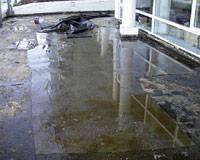Osmosis and the Blistering of Polyurethane Waterproofing Membranes

Cold-applied asphalt-modified elastomeric polyurethane waterproofing membranes(polyurethane membranes) have been popular for roofing and waterproofing applications in the Pacific Northwest and British Columbia for at least the past 15 years. Their relative low cost and easy application resulted in their widespread use in inverted roof and waterproofing membrane assemblies (IRMA), applied to concrete decks. However, water filled blisters under these membranes have been discovered on numerous buildings in the Pacific Northwest in recent years. In some cases, the blisters were so large that replacement of the membrane was required. Water leakage to the interior can result when the blister expands to a crack or joint in the concrete slab.
The local building science and roofing industry is aware of the problem. However, there is a lack of understanding of the causal effects and the moisture transfer physics involved. Water vapour diffusion and capillary flow do not adequately explain the pressures or volumes of water contained within these discrete water blisters. Moisture transfer via osmosis can result in blisters under significant pressure and potentially explains the observed conditions. Osmosis is the physical transfer of water through a semi-permeable membrane when separating solutions of different dissolved ion (salt) concentrations. Under osmotic pressures, water will flow through a membrane from the less salty side to the more salty side in an effort to reach equilibrium.
A series of laboratory experiments were performed to demonstrate that the required conditions for osmosis to occur exist in the field. Laboratory testing of several of these membranes confirmed they are semi-permeable to water (in order of 1 to 8 US Perms for typical thicknesses). We also confirmed a significant dissolved salt-ion concentration in the water collected in the field from beneath the membranes.
Finally, osmotic flow was measured through several of the membranes using a controlled laboratory apparatus. The measured flow through these membranes in the laboratory is in the correct order of magnitude to explain the large water filled blisters and pressures observed in the field.
This paper demonstrates osmotic flow through polyurethane membranes and attempts to create an industry awareness of the issue. Ongoing research is underway to refine polyurethane waterproofing membranes to reduce their susceptibility to osmosis and prevent future occurrences of water filled membrane blistering.


Add comment
Log in to post comments